
Stay Healthy on a Long Tour
Cycling brings good health;
good health brings better cycling
I am perhaps the only member of my family who is not a compulsive worrier. Consequently, before I started the Tour I had the pleasure of listening to repetitive streams of advice generally trying to convince me to skip the endeavor, lest I surely come down with Bird Flu. I had already completed a number of tours, including a few in some out-of-the-way places, so I had a pretty good idea what I should be concerned about in terms of health while on the road. Because I would be spending a great deal of time in the tropics, I did the customary thing and visited a travel medicine clinic before I departed. Apart from a barrage of vaccinations, setting me back close to nine hundred dollars, that exercise provided little in the way of helpful information. On this page are some of my thoughts and experiences relating to that subject. I'm sure I don't need to remind readers that these words do not emanate from a trained medical professional, just from someone who has successfully bicycled the circumference of the Earth–twice.
Fitness & Injuries
It should come as no surprise to anyone that 25-50 hours of cycling per week, almost every week, for over three years, puts one in probably the best physical condition of one's life. The longest tour I had done previously was only two months in length, however, so I had no real idea before I started just what effects such a long tour would have for me. Though I have cycled regularly for many years, in the months immediately before my departure, with myriad tasks and issues to deal with, I did very little riding, and so on my first day in Tasmania, I was certainly feeling a little fat and sore. I had known from those earlier tours that in about a week I would regain my legs, and after a month significant weight loss would begin. Both of those situations occurred right on cue, and by the time I was two-thirds of the way through Stage 1, I tipped the scale at probably 15 kg below what I consider to be my ideal body weight. Had I continued to lose body mass at that pace I would have completely disappeared somewhere in Ecuador. Though I indeed dropped some more in Asia, where I probably exhibited the skinniest appearance of my entire life, I managed, fortunately, to avoid a complete diminution of form.
In Africa, much to my surprise, given the often-meager selection of food in certain places, my previously declining mass seemed to stabilize. In fact, if I could freeze that moment in time, and have that level of body conditioning for the rest of my life, I would do that in a heartbeat, as I have never felt stronger and more comfortable. However, that didn’t seem to be part of the plan for me. Starting at the very end of Stage 3, and especially during the two-month long Atlantic crossing, I began to regain the body mass I had previously lost. Quickly gaining weight while at sea, where I had little opportunity, nor desire, to be honest, to get much in the way of exercise, did not surprise me at all, but continuing to do so, from time to time, during Stages 4 and 5 certainly did. There, my cycling pace was just a little off, relative to earlier Stages, and food and drink were often much more readily available. Nevertheless, it seemed odd that I frequently gained weight, mostly lean body mass in my torso, since my food intake was not that much more than it had been in Australia. However, that is what happened, at least in the lower, warmer parts of the continents. Only in the cold areas of the far south, and in the high mountains, did I begin to return to the overall body mass that I exhibited in the early Stages. I have no definitive explanation for this situation, but my theory is that my body chemistry had adapted to the new regime of exertion that was forced upon it, and made every effort to increase my mass to what it considered to be necessary. In the months after my return, with numerous backed-up responsibilities and chores preventing much in the way of exercise, that situation, unhappily, continued, causing me to search for, so far futilely, some way to approximate the energy balance I had during the Tour within the constraints of "normal" life.
One additional change, which I understand is not uncommon for participants in endurance activities, was a rather large increase in lung volume. This effect was probably enhanced by the fairly lengthy amount of time I spent at high altitudes. While larger lungs may sound like a great thing, and in most respects it is, the human body is not really designed for that, and when they increase in size the main result is that the rest of one's organs in the lower torso get a little crowded, which, as you might expect, is not all that comfortable. Not to mention the fact that the outward distortion of the diaphragm, the muscle at their base, looks, admittedly, rather odd. I have no idea whether this sort of change is reversible over time, or if I will be breathing extra deeply for the remainder of my days. I had hoped to subject myself to a battery of fitness tests, of the type used by professional athletes, as soon as I returned home, to gauge the magnitude of that, and all the other physical effects of such a long tour. Unfortunately, I could not locate a facility in my area that could perform such measurements, and so I will simply have to assume that when I reached the end of the Tour I was in the best shape of my life.
Where injuries are concerned, there are two types that can potentially affect cyclists; the completely preventable kind, and the unfortunate, random sort, with an early end to a tour being the worst possible result in either case. The first class is stress-type injuries caused by the repetitive motions of cycling itself. Almost exclusively, these are caused by using a bicycle that is not sized properly for the rider's body dimensions. However, in this day and age it is completely unfathomable that anyone should have to attempt a long tour on a bike that was not perfectly fitted to their size. Unless a rider is the epitome of the "average" body size, the one size fits all method of bike outfitting should be completely discarded. There are dozens of major parts and components on a modern bicycle and only a handful should not be sized according to the rider's dimensions. This is especially true for riders at the extremes of typical human sizes, such as a fairly tall person, like me. Of course, this entails a lengthy, and perhaps costly, process of trial and error in order to determine exactly what size each component should be, but doing so is absolutley worth the effort. I had spent many hours investigating such issues, had my bike's frame built by a quality framebuilder, had educated myself in the intricacies of bike fitting, and most importantly, used my bike for 18 weeks of touring before I started the Tour of Gondwana. I was completely confident, therefore, that I would have no problems, and the actual number of hours I spent in discomfort caused by cycling during the 40 months of the Tour turned out to be: zero.
The other potential type of injury one might expect, or perhaps should expect, to receive during a long tour is those caused by often random, usually accidental, but potentially violent collisions, falls, or other events beyond the normal tolerances of a human body. There are certainly a lot of massive objects possessing a lot of kinetic energy out there, including, or course, the touring cyclist themselves, which, when encountered unexpectedly, can ruin a rider's day. The likelihood of such misfortunes depends, in large part, on one's level of self-confidence, as well as any history of being accident-prone. Of course, there are also events beyond one's control, such as being hit by an aberrantly-driven bus, or similar occurrence, though such troubles are possible in everyday life, whether one is on tour, or not, and so should not necessitate extra levels of concern. If one's route includes a high amount of time on off-road trails, then the extra obstacles frequently found there are also potential sources of mishaps. None of these situations should be expected to disrupt an otherwise great tour, however, provided one keeps their wits about them. Of course, though there is really no such thing as the "Law of Averages", given enough time it is almost certain that a cyclist on a long tour will go down at some point.
In my case, I seemed to be rather lucky during my Tour. While I did hit the ground on a few occasions, mostly in Asia, my poor bike usually took the brunt of any fall, whereas I, myself, frequently came through unscathed (an example of such an occurrence is given in this post.) One case where the opposite happened was in Tanzania, the day before I was to begin a trek up Mount Kilimanjaro, and was the only significant injury I suffered during the entire Tour. It is a rather long story (described in more detail in this post,) but suffice it to say that I learned that day that the second-most dangerous creatures in Africa are a seven-year-old human boys (the first are bees.) The result of my encounter with this miscreant was a severely sprained left wrist, which made using its attached hand for anything, most notably cycling, completely impossible for a period of over a month. However, if that was the worst damage I did to myself over all that distance, I suppose that I should feel rather lucky.
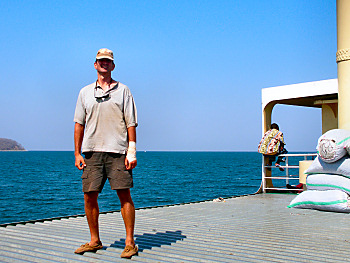
Me on the Lake Tanganyika ferry, showing off my damaged wrist
Withering Heights
It is, of course, possible to plan a route for a very long tour that does not venture into the rarified atmosphere of the World's most lofty mountains. Doing so would bypass some of the most compelling destinations the Earth has to offer, however, and many touring cyclists, including me, choose to drop into their grannies and make the slow ride up to altitude, at least for part of the time. This brings a new risk to the forefront, namely the mysterious malady known as Altitude Sickness, or hypobaropathy. Apart from the ultimate cause, breathing air at significantly less than sea-level pressures for an extended period of time, its mechanisms in, and effects on, the human body are not well understood. It is, though, a condition that is not to be taken lightly. Confusing the situation is a complete lack of predictability for its occurrence in any given situation. Some people may be affected at lower altitudes, relative to others; some people may be very experienced traveling at high altitudes, never having problems until one specific trip; and some may never experience symptoms at all. It is also said that one's level of fitness has little bearing on the likelihood of developing a case, though with regards to the above-mentioned increases in lung capacity of many cyclists, I'm not sure I am in complete agreement with that position.
Given the uncertainties about this problem, common knowledge should never be trusted completely. However, there are three preferred approaches to dealing with this condition, prevention by proper acclimation, a return to lower altitude upon onset of symptoms, and, when those are not practical, or inaffective, breathing air enriched with oxygen, or resting in a hyperbaric chamber. The first of these is obviously the recommended course of action for all traveling to high altitudes. In cases where symptoms are not severe, the body will normally adjust to the changed environment and symptoms will disappear on their own after a length of time.
I have never experienced any symptoms from this condition at elevations below 4,000 meters. However, there were a few periods, of varying lengths of time, during the Tour when I was at that height, or higher. The only one of those that gave me any trouble was in Tibet. Despite ascending at what seemed like a very slow rate, and taking a full day off at 3,500 meters, I developed some fairly mild symptoms once I reached the Tibetan plateau. In my case, I was mostly fine in the daytime, but had significant trouble sleeping, waking every few minutes with the startling feeling that I was about to suffocate. Fortunately, after a few days those feelings disappeared, never to return. The remaining ascents to altitude; my trek to the summit of Kilimanjaro at 5,990 meters, and numerous passes in the Andes above 4,300 meters, did not cause me any additional difficulties. The latter was certainly facilitated by the particular route I used for my initial ascent to the Andean Altiplano in Argentina, which climbed in a friendly, step-wise manner over a period of a few days.
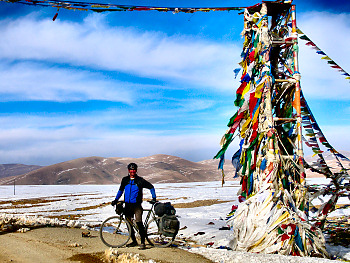
Me at Lalung La, Tibet. 5,105 meters a.m.s.l., and definitely light-headed
Attacks From the Air
They are the second most annoying creature on the face of the Earth, surpassed in their annoyingness only by the flies of Australia. However, they outdo all others by adding a menacing threat of sickness to their arsenal of disturbing behaviors. They are the bane of the tropics, the disquieters of solitude, the despoilers of natural relaxation, and a major pest to touring cyclists. They are the omnipresent mosquitoes. Itching and buzzing aside, their real danger is that they are one of the most efficient vectors for a number of serious diseases.
The most relevant, and one of the most difficult to combat, is malaria. The standard advice to travelers in the areas where the plasmodium parasites, the actual cause of the sickness, are endemic is to take a preventative course of any of several anti-malarial drugs. I did that on my first trip to Madagascar, with no ill effects; however, for the much longer Tour of Gondwana I was concerned about the possible adverse effects of long-term usage of any of those rather strong medications. Serious side effects are also known to occur in some people when using such measures. These can be the types of problems that would be bad for anyone, but disastrous for a touring cyclist, including increased sensitivity to the Sun with doxycycline, and psychological problems with Lariam. In the end, I decided against using any such drug, going against the advice of the medical establishment.
Fortunately the usual method of catching malaria provides an opportunity to avoid the disease by taking appropriate precautions. Specifically, the protozoan plasmodium parasites, which cause the illness, are transmitted by a bite from a female mosquito of the genus, Anopheles, a type found only in the tropics, and whose species is known to only feed at night. With that in mind, and understanding that the best defense against catching the disease is to avoid being bitten by an infected mosquito, there are several simple precautions that can be taken. Some of these are practices that will enhance the enjoyment of a tour in any case, and so are simply good common sense.
- Know the areas of the World that are known to harbor malaria parasites. This information is easily found on the Web, but the data there are often over-generalized, listing entire countries as infected areas, when only a small portion may in fact be;
- Make every effort to schedule tours in those areas during the region's dry seasons, when mosquitoes are often virtually absent. This, of course, should be done in any case, for obvious reasons;
- Anopheles are usually absent at higher elevations. Try not to spend 100% of the time in the lowlands of problematic regions. Cycling at high elevations in the tropics is a blast in any case;
- When camping, use only a good-quality tent without holes or tears. Set up no later than sunset. Make your first task, immediately after zipping up, killing any mosquitoes that may have found their way inside with you. Do not unzip the tent–for any reason–during the night. This last matter may involve a little getting used to, but once you have that worked out, it is actually a preferable practice;
- When staying indoors, bypass the typical bargain-basement tourist lodgings, which are likely to be heavily mosquito infested. A bed net, a very strong fan, or air conditioning, are mandatory;
- When staying in towns, skip the long evenings at the outdoor pub chatting with other tourists, which make oneself easy prey for anopheles.
I did my best to follow these guidelines while on the Tour, and did not catch malaria. I should point out that I am not trying to offer advice that medications should not be used. However, even when using one of the mainstream anti-malarial drugs, the methods above are still important and provide an extra level of protection, not to mention comfort. It may be that I was simply lucky. In fact, I did meet two other cyclists on a long tour of the Americas, who seemed to have their act together in most respects. They took a route straight through the Amazon basin, and both contracted malaria in that region. I could tell that, while they were able to complete their tour in the end, coming down with that illness was something they were none too pleased with. I do not know the exact circumstances under which they became infected, but I would be surprised if they had been less than careful. In the case of the Amazon, where the dry season is only "less dry," extra precautions may be a good idea.
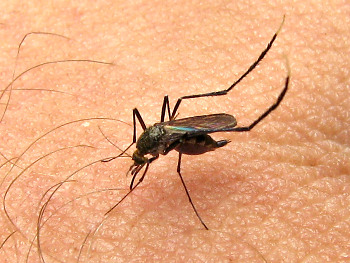
The enemy of touring cyclists
Unfortunately, malaria is mot the only mosquito-born disease that is present in the tropics. Recently, Dengue Fever, a particularly nasty disease spread by mosquitoes from the genus, Aedes, has been gaining ground. Currently there is no vaccine for Dengue and available treatments are not especially effective. The disease can be fatal, though those who don't succumb usually recover fully–eventually. Nevertheless, the symptoms sound unpleasant, and avoiding this sickness would be of paramount importance. Doing so presents a slightly different set of circumstances, relative to malaria, as Aedes feed during the day. Since actual infection rates are still fairly low, an order of magnitude below that of malaria, avoidance is still the best course of action.
Visiting a region during its dry season is probably, once again, the best idea, though beyond that there is not much else a cyclist can do. I, personally, have never found commercial mosquito repellents to be especially effective, no matter how much DEET they contain. Those products will be even less use to cyclists, especially those vigorously riding through humid environments, as perspiration will quickly wash them from one's skin. One potential recourse is to keep an eye on regional news sources for any Dengue epidemics that may lie ahead on one's route. This could provide ample cause for rerouting around the affected area. Prior to my arrival in Paraguay, there had been an outbreak there in the previous wet season, which I missed. A similar situation struck Rio de Janeiro during the rainy season that followed my visit. By arriving in both places during their dry seasons, I avoided any increased risk, and fortunately, did not catch the disease.
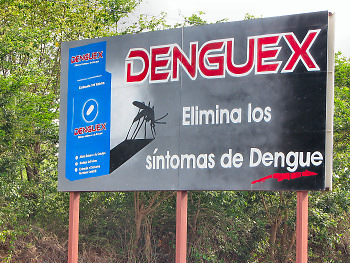
Eliminate the symptoms, pehaps. There is no cure
Corrosive Environments
Being out in the open for extended periods is not always kind to one's body, and the exertions of a long tour may tend to exacerbate any negative effects. The intense rays of the Sun are the type of environmental factor that can cause both immediate discomfort and long-term harm, as almost everyone knows. I was actually a little surprised at percentage of time during the Tour in which I did not find that to be much of a problem. There were enough cloudy, rainy, hazy, shady, or cold days to allow my exposed skin to catch a break. To be sure, various locations, including East Africa, parts of Australia, and central Mexico, were rather brutal and I spent my time in those areas constantly wincing due to cracked lips. A good sunscreen is, of course, a sensible precaution. However, using one all the time tends to be rather impractical on a long tour. That led to my most common problem, namely, riding blissfully unconcerned for a few cloudy weeks, and then suddenly emerging into the bright Sun of a new location, where I would carelessly forget to watch out for overexposure until it was too late.
Another unwelcome environmental problem is the often unpleasantly dirty air still found in many parts of the World. Asia was the worst part of my route in that regard, and the air quality in many places there was absolutely abysmal. Garbage fires, fueled by an ever-increasing amount of plastic trash, and agricultural fires were a major cause of the smog found there. The latter were also the origin of a giant smoke cloud that covered a region in central South America equal in size to the half the United States, which made my visit to that area less pleasant than it should have been. The most disagreeable source of foul air was, of course, the many vehicles with which I was forced to share the roadways. The worst of the lot are the antiquated diesel motors usually found on overworked trucks and buses. The thick, stinky, billowing clouds emanating from their exhausts might be comical were they not so harmful. Diesel exhaust is a sickening goulash of harmful substances, and, unfortunately, there is really no practical way to avoid inhaling continuous lungfuls of the nasty vapors while cycling. Again, Asia was perhaps the worst place for that type of pollution, but it was common in many other places as well. When one blows their nose, and what comes out is black, you know that there is a problem.
Both of these environmental factors may cause temporary discomfort, but their real affects on the body may not manifest themselves for many years. Hopefully, the length of time I was out there in the Sun and smog will not cause me any significant problems later on.
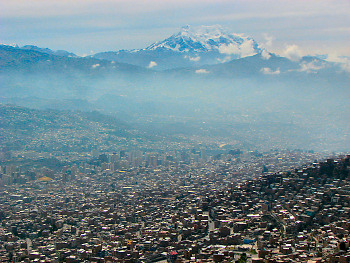
La Paz, Bolivia, one of the smogiest cities I saw
A similar pollutant that can cause immediate effect, and one that surprised me with its prevalence, is dust. The problem is worst on unpaved roads that carry heavy loads of motorized traffic. However, many cities and towns around the World are laced with unpaved streets as well, and dust from those is constantly blown up, aided by the activities of the local residents. While this problem crops up from time to time everywhere, once again, Asia was the toughest place for me in that respect. Compounding the trouble there is the great number of domestic animals that have free roam on the highways and streets. Their fecal matter is quickly dried and dispersed along with the ambient dust, forming an infective aerosol that is impossible to avoid completely.
Constant exposure to dust is, at best, an unpleasant annoyance. In my case, I took things a step further, and developed a recurring case of bronchitis. While not debilitating, the powerful bouts of coughing associated with that condition can make cycling rather difficult, not to mention causing embarrassment by keeping everyone else in the surrounding area awake at night. Dust, especially the sharper types found around certain kinds of crushed-gravel roads, can severely irritate a person's bronchial passages, leaving them vulnerable to infections from viruses or bacteria. When those microbes are carried aloft on the dust itself, the likelihood of contracting the condition rises dramatically. Coughing, with its associated tiredness, is the only main symptom, but it can take many days for the infection to heal, so this condition can put a significant drag on a tour's progress and enjoyment. I first developed bronchitis after riding over several sections of dirt road in Cambodia. Recurrences occurred perhaps eight additional times, almost always in other areas with poor air quality. Most of those were in Asia, yet again, though episodes continued, less frequently, until I was halfway through Stage 4. I was occasionally concerned that the condition might become chronic, as is known to happen, or that it could trigger exercise-induced asthma, but, fortunately, neither of those situations came to pass.
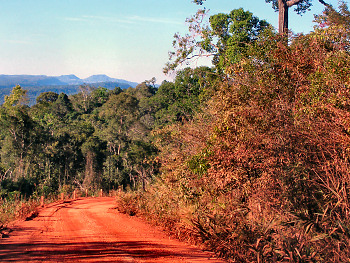
Dust from a Laotian road turns everything nearby orange, including cyclists
The Unavoidable Threat
The malady that comes to mind first, whenever someone considers traveling in the southern world, is probably the infamous condition often caused by food-born microorganisms. I'll skip any description of the symptoms, since I assume that everyone knows the situation. Suffice it to say that in lands where quality restroom facilities are often few and far between, having a microbial population explosion occurring in one's digestive tract is not conducive to easy travel. For cyclists, the effects are more relevant, as maintaining a level of energy required to cover typical touring distances requires effective processing of large quantities of food. Most of the recommendations for avoiding these troubles are geared towards mainstream travelers, and, therefore, often of little pertinence for touring cyclists. Some of these are so ingrained into the tourism industry that the prevention memes are readily apparent in many places, such as in Nepal, where I saw a sign in a typical restaurant stating; "Our Lettuce is washed with iodized water!" However, the standard guidebook phrase about cooking, boiling, and peeling, should probably be forgotten; for more than one reason.
For touring cyclists the most important of those is the need to keep energy levels up as much as possible, especially given the constraints of food availability beyond normal tourist places. No matter how hard one tries to avoid potentially contaminated food and drinks, sooner or later something that looks suspicious will be the only thing available. Given the choice between eating something that might lead to diarrhea, or doing without and almost certainly collapsing from lack of energy, or fluids, on some lonely country road, I certainly would choose the former. Further complicating the issue is that most of the street food, which is so often blamed for causing trouble for travelers, is usually quite well prepared and safe to eat, while the occasional restaurant catering to tourists by serving "International Dishes" can often be much more treacherous. That may be due to the need for uncommon ingredients in western recipes that may need refrigeration, butter, for example, or methods of cooking unfamiliar to local chefs. I can personally attest to this situation, having fallen victim to the lure of familiar, but potentially unsafe, "Western" food on more than one occasion.
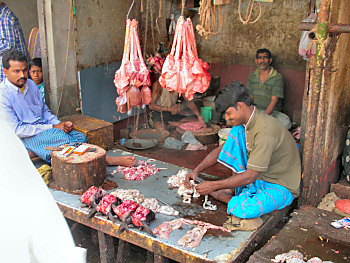
That Western-Style meal in the tourist hotel; it probably came from here
Another reason that prevention by avoidance of certain foods and beverages is not a complete solution lies in the general environment found in many places. A key culprit is the dust already mentioned above, specifically the type found around towns and cities, which may be laced with microbes that originated in animal wastes. No matter how carefully one watches their food sources, breathing such pollutants will cause a case of distress as surely as eating a poor Chaat. With that in mind, there is really no way to avoid such sicknesses completely. This is even more germane for travelers from the northern hemisphere, who will likely have little immunity to the microorganisms found in the south. Consequently, this type of sickness is something that must be accepted as essentially inevitable on a long tour in remote locations.
To avoid lengthy, and less than pleasant, downtime during a tour, managing the unavoidable cases, whatever there cause, is probably the best one can do. I have always preferred to avoid medications whenever possible, and so would normally choose to let such an infection run its course naturally. Of course, that can mean days off the bike, or at best extremely slow and tiring progress, thanks to reduced levels of energy. I now think that treatment with antibiotics is probably the best course of action. In a way similar to the common cold, however, the situation is complicated by the large number of pathogens that can cause common symptoms, meaning that one medication might not work well in all cases. One tactic that I did find useful was to begin use of whatever medication I had at hand at the earliest sign of symptoms. That usually led to a much shorter recovery time. I also found it worthy of note that medications that would be available only with a prescription back home were easily available over-the-counter in areas where travelers frequently suffer from such conditions. One type of medication that I would whole-heartedly urge tourists to not use is Loperamide, most commonly, but not always, sold under the brand name Imodium. This type of drug may stop one's symptoms, but may also completely shut down the digestive system during its use. That is what happened to me on an earlier tour, after the one, and only, time I used that drug, and I can scarcely remember a more unpleasant time during my entire life.
It may be that a certain amount of acclimation occurs during a long tour, as well. As far as my Tour was concerned, I contracted symptoms numerous times; one very mild case in Stage 1, shortly after returning from Papua New Guinea; probably six or seven times in Stage 2, though it was hard to tell, as the cases there sometimes seemed to come and go, and I may have had only a few longer illness; two or three times in Stage 3, and only once in Stages 4 and 5. This, of course, may have been a large factor in my loss of weight through Stage 3, and then my propensity for gaining some of it back staring in Stage 4. Whether that was true, or not, I certainly didn’t mind that, after a while, I did not have to deal with such unpleasantness very often.
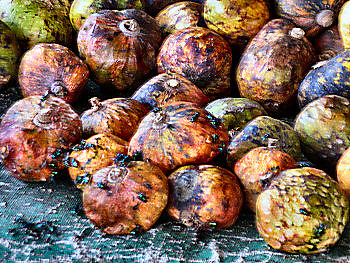
Mmmm... Delicious tropical fruits. Comes with a Side of Flies!
So for the entire 40-month Tour, through 44 countries, including several rather traditional places, here is the sum of the health issues I had to deal with: one sprained wrist; occasional bouts of bronchitis over an 18-month period; about ten cases of G-I malfunction; and one lengthy head cold. Overall, I am satisfied with that record.
Previous | Next
Main Index | Pre-Tour Index
Post-Tour Index | Articles Index
Slideshows
Main Index Pre-Tour Post-Tour Articles Previous Next |
To Insure,
or Not?
One of the most frequent pieces of advice given to potential travelers from mainstream sources, guidebooks and televised travel shows, is to obtain a travel insurance policy before leaving home.
I was required to have an insurance policy before booking passage on container ships, and in those cases I obtained the least-costly available policy, valid for the length of the cruise only. Beyond that, I did not purchase insurance of any kind for the Tour. Here is my reasoning:
~ Length of the trip. Most travelers' policies would be issued for a maximum of 12 months only. Obviously, I was going to be gone longer than that, and I believe I would have had difficulties acquiring a second policy once I had already left home.
~ Nature of the trip. Most insurers add additional charges for travel involving "Extreme Sports", or may not cover such types of travel at all. While I don't think cycling is extreme, I assumed that insurance companies might think doing so in Papua New Guinea, for example, would be.
~ Cost differences. Most Americans, like me, are accustomed to a short hospital stay, or other medical situations, having the potential to completely wipe out one's life savings. In other parts of the World, medical costs are much more reasonable, and basic services would not be expected even to exceed normal traveling expenses by much.
~ Lack of paranoia. Tales are frequently spun online about someone who had to be flow off a mountain in Nepal by a medivac helicopter, or other drastic rescue circumstances costing tens of thousands of dollars. Let's be serious. If any really grim conditions were to befall a touring cyclist, there are not going to be any choppers coming to the rescue. Collisions in traffic would be the most likely catastrophe, and in that case one would be transported to the nearest medical facility the way the local people are, even if that means riding in a donkey cart.
~ My own resources. Even for the most budget-conscious tourists, a three-year tour will require a significant pile of cash. Unless whatever misfortune befell one occurred right near the end of the tour, there should be ample cash in one's accounts to cover any potential problems. If those problems were extremely severe, and/or costly, then, let's face it, the tour would probably be over at that point anyway.
~ Cancellations are minor. The only other things that an insurance policy might assist with are events like flight cancellations, lost bags, and so on. Those things occur from time to time during any long-term travel, but such logistical costs should really be minor components of the budget of a long tour. Making adjustments or replacing lost gear would not seem to me to be worth the cost of the policy.
So, I felt completely comfortable going out on a long tour without any sort of financial "coverage" at all. The only time I would recommend acquiring such a policy to others doing a long tour, is if they had some sort of known medical condition that might cause problems later on. In that case, however, I would think that carefully choosing a route that avoided remote locations would be even more important.